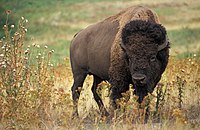
Photo from wikipedia
The prevalence of tail lesions evaluated at the slaughterhouse varies considerably between herds. These lesions result mainly from tail biting, a harmful behavior with multifactorial origin. This study sought to… Click to show full abstract
The prevalence of tail lesions evaluated at the slaughterhouse varies considerably between herds. These lesions result mainly from tail biting, a harmful behavior with multifactorial origin. This study sought to investigate if a batchwise inspection of tails at slaughterhouse could be a useful method to estimate the animal welfare situation in finishing pig herds, and if so, what type and detail of tail scoring such an inspection should utilize. We investigated the distribution of different types of tail lesions and how well their scoring at slaughterhouse was associated with the situation recorded on-farm by a veterinarian as part of routine herd health visits. We also wanted to determine if animal welfare-related herd-level parameters, recorded by herd veterinarians during herd health visits, are associated with tail scoring at the slaughterhouse. A total of 10,517 pigtails from 84 herds were scored for this study. Herd data were collected from the national health classification register for pig farms in Finland and also included annual herd production quality data collected by the slaughterhouse. The scores of the tails varied considerably between the herds. On average, 48.1% (sd = 19.3) of the tails with an average length of 30.4 cm (sd = 2.7) were fully intact, 37.3% (13.9) had healed (length = 26.4, sd = 5.1 cm), 12.4% (9.0) (length = 28.9, sd = 4.3 cm) had minor acute wounds, and 2.3% (2.1) (length = 24.2, sd = 6.0 cm) had major acute wounds. Proportions of different tail lesions at slaughterhouse were associated with or tended to be associated with the following herd-level parameters in regression models: use of wood as enrichment (p < 0.1), one health parameter (leg problems other than arthritis, p < 0.05), and long-term animal welfare estimate (annual mortality, p < 0.05). Detailed tail evaluation at the slaughterhouse shows potential in estimating the tail lesions and long-term welfare level on the farm. By recording only one type of tail condition (such as tails with major acute lesions) at the slaughterhouse, it is not possible to estimate the total tail lesion situation in the herds before slaughter. A more detailed scoring similar to the one used in this trial is recommended.
Journal Title: Frontiers in Veterinary Science
Year Published: 2021
Link to full text (if available)
Share on Social Media: Sign Up to like & get
recommendations!